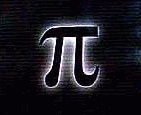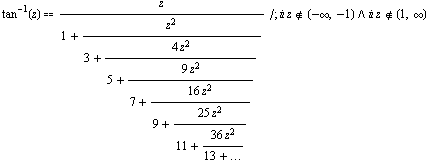
Calculating digits of pi using a continued fraction representation:
- The Ruby release has a remarkably short and simple Ruby program that calculates
arbitrarily many decimal digits of pi, using the
continued fraction on the left:
Ruby program to calculate pi The Formula used #!/usr/local/bin/ruby k, a, b, a1, b1 = 2, 4, 1, 12, 4 loop do p, q, k = k*k, 2*k+1, k+1 a, b, a1, b1 = a1, b1, p*a+q*a1, p*b+q*b1 d, d1 = a/b, a1/b1 while d == d1 print d $stdout.flush a, a1 = 10*(a%b), 10*(a1%b1) d, d1 = a/b, a1/b1 end end
Output of a run % pi.rb 3141592653589793238462643383279502884 ...
- How the algorithm for Pi works shows how this algorithm can be adapted to compute any continued fraction.
- Here is an expanded verion that arranges the digits by 10s
and in rows of 100. Given an optional command-line
argument, it calculates pi to any base B <= 36.
Ruby program to calculate pi to any base Output of runs #!/usr/bin/env ruby k, a, b, a1, b1 = 2, 4, 1, 12, 4 h = %w{0 1 2 3 4 5 6 7 8 9 a b c d e f g h i j k l m n o p q r s t u v w x y z} if ARGV[0] == nil B = 10 else B = ARGV[0].to_i end dig = -1 row = -1 loop do # Next approximation p, q, k = k*k, 2*k+1, k+1 a, b, a1, b1 = a1, b1, p*a+q*a1, p*b+q*b1 # Print common digits d = a / b d1 = a1 / b1 while d == d1 if dig == -1 then printf " " print h[d] dig = dig+1 else print h[d] dig = dig+1 end if dig%10 == 0 then printf " " end if dig%100 == 0 then row = row+1 printf "\n%4i ", row end $stdout.flush a, a1 = B*(a%b), B*(a1%b1) d, d1 = a/b, a1/b1 end end% piA.rb 3 0 1415926535 8979323846 2643383279 ... 1 8214808651 3282306647 0938446095 ... % piA.rb 16 3 0 243f6a8885 a308d31319 8a2e037073 ... 1 29b7c97c50 dd3f84d5b5 b547091792 ... % piA.rb 36 3 0 53i5ab8p5f sa5jhk72i8 asc47wwzla ... 1 067iy9wnzd z9n4jltedt iw2b65acrp ...
Outputs of the above program:
-
I checked that the answers are correct.
(Well, spot checked the decimal version, and checked at the end.
I also checked the first 55 hex digits, and checked
that 9 hex digits starting at the 5000th and at the 10000th
position are correct.)
- pi to 40000 decimal digits,
- pi to 20000 hex digits,
- pi to 10000 base 36 digits,
- pi to 10000 base 62 digits (using 0-9,A-Z,a-z).
Java version of the second Ruby program above:
-
The program uses BigInteger.
It produces exactly the same
output as the Ruby program, only slower.
| Java program to calculate pi |
|---|
import java.math.*; // for BigInteger
public class PiBig2 {
public static void main(String[] args) {
BigInteger TWO = new BigInteger("2");
BigInteger TEN = new BigInteger("10");
BigInteger k = new BigInteger("2");
BigInteger a = new BigInteger("4");
BigInteger b = new BigInteger("1");
BigInteger a1 = new BigInteger("12");
BigInteger b1 = new BigInteger("4");
int dig = -1, row = -1;
for (;;) {
// Next approximation
BigInteger p = k.multiply(k);
BigInteger q = (TWO.multiply(k)).add(BigInteger.ONE);
k = k.add(BigInteger.ONE);
BigInteger tempa1 = a1;
BigInteger tempb1 = b1;
a1 = (p.multiply(a)).add(q.multiply(a1));
b1 = (p.multiply(b)).add(q.multiply(b1));
a = tempa1;
b = tempb1;
// Print common digits
BigInteger d = a.divide(b);
BigInteger d1 = a1.divide(b1);
while (d.equals(d1)) {
if (dig == -1) {
System.out.print(" ");
System.out.print(d);
dig++;
}
else {
System.out.print(d);
dig++;
}
if (dig%10 == 0) System.out.print(" ");
if (dig%100 == 0) {
row++;
System.out.println();
if (row < 10) System.out.print(" " + row);
else if (row < 100) System.out.print(" " + row);
else if (row < 1000) System.out.print(" " + row);
else System.out.print(row);
System.out.print(" ");
}
a = TEN.multiply(a.mod(b));
a1 = TEN.multiply(a1.mod(b1));
d = a.divide(b);
d1 = a1.divide(b1);
}
}
}
}
|

|
Revision date: 2005-12-21. (Use ISO 8601, an International Standard.)